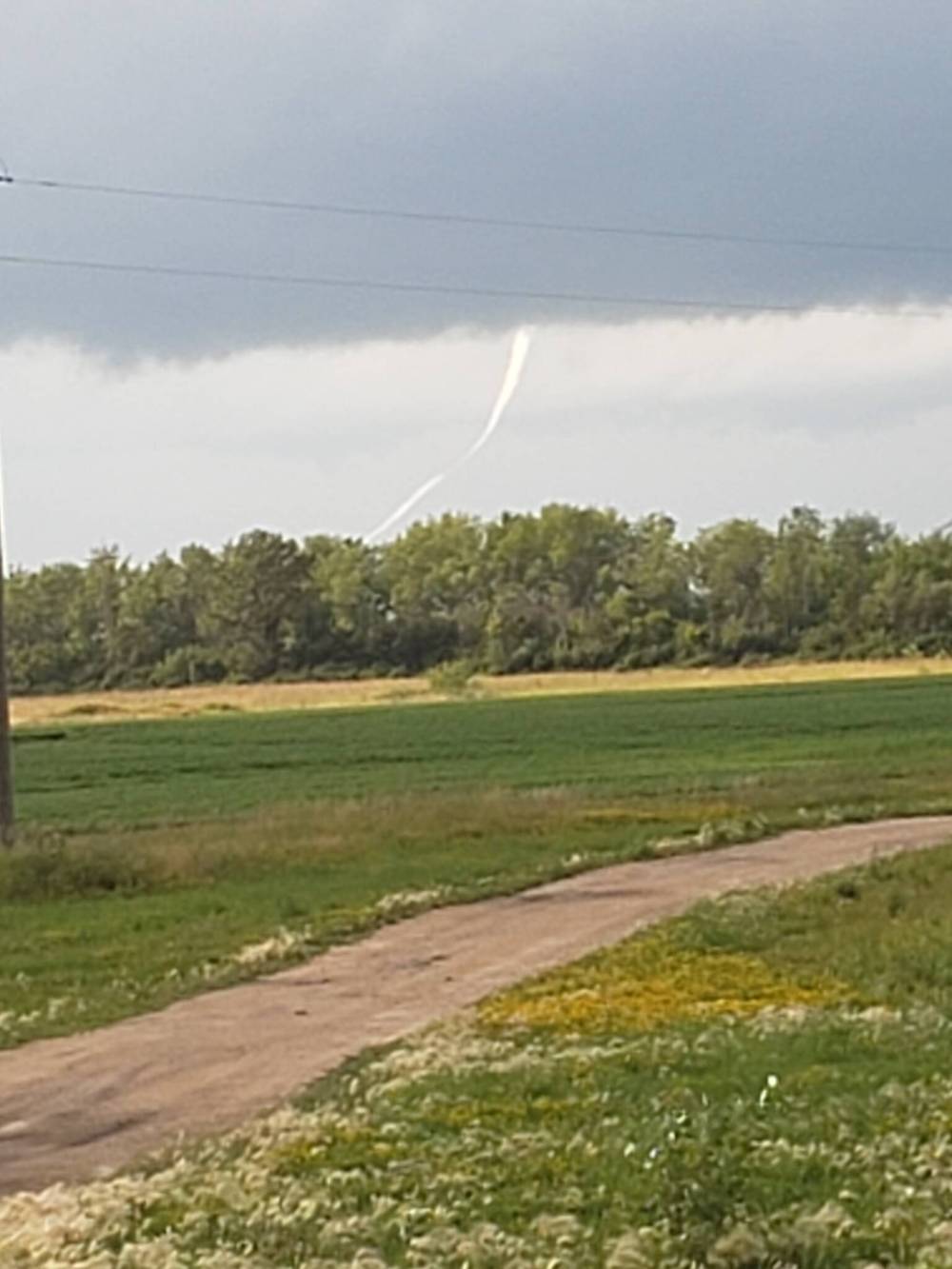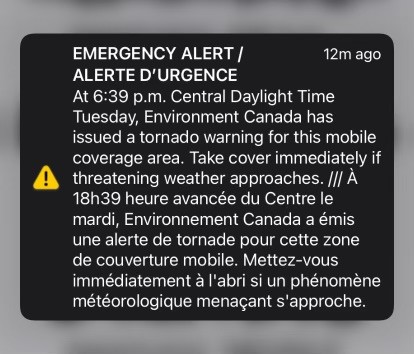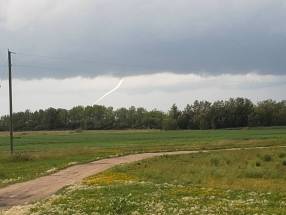Spotty tornado warning leaves many Manitobans twisting in the wind Silent phones before, during Tuesday’s violent Interlake weather spark renewed concerns about unreliable federal Alert Ready system’s outdated technology
Read this article for free:
or
Already have an account? Log in here »
To continue reading, please subscribe:
Monthly Digital Subscription
$0 for the first 4 weeks*
- Enjoy unlimited reading on winnipegfreepress.com
- Read the E-Edition, our digital replica newspaper
- Access News Break, our award-winning app
- Play interactive puzzles
*No charge for 4 weeks then price increases to the regular rate of $19.00 plus GST every four weeks. Offer available to new and qualified returning subscribers only. Cancel any time.
Monthly Digital Subscription
$4.75/week*
- Enjoy unlimited reading on winnipegfreepress.com
- Read the E-Edition, our digital replica newspaper
- Access News Break, our award-winning app
- Play interactive puzzles
*Billed as $19 plus GST every four weeks. Cancel any time.
To continue reading, please subscribe:
Add Free Press access to your Brandon Sun subscription for only an additional
$1 for the first 4 weeks*
*Your next subscription payment will increase by $1.00 and you will be charged $16.99 plus GST for four weeks. After four weeks, your payment will increase to $23.99 plus GST every four weeks.
Read unlimited articles for free today:
or
Already have an account? Log in here »
Hey there, time traveller!
This article was published 03/08/2022 (1224 days ago), so information in it may no longer be current.
Some Manitobans didn’t receive emergency alerts on their smartphones when a tornado touched down east of Teulon Tuesday evening, renewing longstanding concerns about Canada’s national warning system.
When the twister tore across farmland in the Interlake shortly after 6:30 p.m., officials from Teulon and the Rural Municipality of Armstrong happened to be holding a mock tornado drill as part of their disaster-response training.
A short time later, about half the cellphones in the room pinged with a text-message warning from the Alert Ready system, said Teulon Mayor Anna Pazdzierski, whose device did not receive an alert.
The twister tore across farmland in the Interlake shortly after 6:30 p.m.
“If they have an alert system, they need to make sure that alert goes to everybody,” Pazdzierski said Wednesday. “Cell service in rural areas is sporadic. Until they upgrade (it), there are going to be problems.”
Similar concerns were raised after a tornado killed a 77-year-old man in the Rural Municipality of Alonsa on Aug. 3, 2018. Residents said they failed to receive an alert during that disaster.
Some Manitobans didn’t receive a message when a Canada-wide test was held May 8, 2019.
The absence of phone notifications amid Tuesday’s tornado suggests there are still problems with the system.
Local MP James Bezan (Selkirk-Interlake-Eastman), who lives just west of Teulon, did not receive an alert.
His daughter and son-in-law, who live east of the town, got warnings on their phones.
Because some didn’t receive messages, questions need to be asked and improvements need to be made, said Bezan, noting he plans to speak to officials from Environment Canada and some of his Conservative colleagues in Parliament.
“It’s a technology that is still evolving, that still needs to be perfected,” he said. “It is something I’m aware of and concerned about.”
Bezan, who drove around the area Wednesday, said the tornado caused some damage to crops, and hailstones inflicted some property damage.
There were no reports of injuries or damage caused by the supercell tornado, which has been given a preliminary rating of EF0 (maximum wind speed between 105 and 137 km/h causing “light damage”) on the five-level enhanced Fujita scale used by Environment Canada.
Some Manitobans didn’t receive an emergency alert on their smartphone when a tornado touched down east of Teulon Tuesday evening.
Brittany Kargus saw the tornado touch down while she was at a friend’s house near Petersfield. Neither she nor her friend received an alert on their phones, she said.
“It was definitely kind of surreal,” she said of witnessing the tornado. “I haven’t seen anything like that in many years.”
Kargus’s sister, Cori Norquay, was on a farm near Petersfield when she received the warning on her phone.
“I was already staring at the tornado when I saw (the alert),” she said.
Pelmorex Corp, which is based in Oakville, Ont., runs the Alert Ready technology on behalf of the federal government. Environment Canada is responsible for writing and sending alerts when warranted.
Since 2018, the system has been delivering alerts to phones to warn of severe weather and other emergencies. Urgent messages are also broadcast on television and radio stations.
To be capable of receiving an alert, a phone must be wireless public alerting (WPA) compatible, and it must be connected to an LTE or 5G cellular network, Pelmorex’s director of public alerting, Martin Bélanger, said in a statement.
Local MP James Bezan, who drove around the area Wednesday, said the tornado caused some damage to crops, and hailstones inflicted some property damage.

The phone must be equipped with the latest operating software.
“A user will not get an alert if they are on 3G or if they are using an older cellphone that operates exclusively on non-LTE or non-5G networks,” said Bélanger.
Kargus said her phone meets those requirements, but she didn’t get an alert, although she has received them in the past.
Kaitlin Power, a spokeswoman for Environment and Climate Change Canada, said the federal agency is “continually working” to improve its ability to forecast complex weather systems and “provide the best possible service.”
A spokesperson for the province said not all Manitobans will receive alerts on their mobile devices.
“This may occur for a variety of reasons — device compatibility, connection to an LTE network, cell tower coverage and device software and settings,” the spokesperson wrote in an email.
People who did not receive an alert should contact their wireless provider to find out why, the province said.
Separate from the phone alerts, Environment Canada meteorologists issued a mix of watches and warnings before and during Tuesday’s severe weather.
Natalie Hasell, a warning preparedness meteorologist, said tornado watches were issued for the Selkirk and Arborg areas at 3:35 p.m., while severe thunderstorm watches were issued for other areas five minutes later.
“A user will not get an alert if they are on 3G or if they are using an older cellphone that operates exclusively on non LTE or non 5G networks.”-Martin Bélanger
A severe thunderstorm warning went into effect for the municipalities of St. Andrews and St. Clements at 6:36 p.m.
A tornado warning was issued at 6:39 p.m., when Environment Canada confirmed a twister was on the ground between Teulon and Netley.
Often, a warning isn’t issued until a tornado is spotted on the ground, said Hasell.
Confirmation of Tuesday’s tornado was received when witnesses, including experienced storm chasers, posted photos on social media.
“Often, you don’t get advance warning,” said Hasell.
Severe thunderstorms capable of producing tornadoes can develop in as little as 20 minutes, and precise locations are difficult to predict, she said.
An alert was sent to phones when the tornado warning went into effect.
“Once we send it, it’s kind of out of our hands.”-Natalie Hasell
Hasell said all “newish” phones should be compatible with Alert Ready.
Some users may not have received an alert if they weren’t close to a cellphone tower, she said.
“Once we send it, it’s kind of out of our hands,” she said, citing Pelmorex as the operator of the National Alert Aggregation and Dissemination (NAAD) system, which Alert Ready is based on.
Scott Kehler, president and chief scientist of Winnipeg-based Weatherlogics, said the situation highlights issues with the federal government’s weather warning system.
He described it as “decades out of date” and “very imprecise.”
“It’s a major problem that needs to be addressed,” he said.
The warnings themselves are issued for huge areas, said Kehler, while the Alert Ready system isn’t good at targeting cellphone users within a warning area.
He said Environment Canada has been slow to adopt new technology that would allow its meteorologists to, among other things, give more precise warning areas, as the U.S National Weather Service does.
“I’ve never seen something like that before. The cloud was square (in shape), I just couldn’t believe.”-Murray McConnell
Meanwhile, Environment Canada is still investigating Tuesday’s storms, including reports of waterspouts in the south basin of Lake Winnipeg.
Tornado reports, including photos and video clips, can be emailed to MBstorm@ec.gc.ca.
Murray McConnell, who lives about 11 kilometres east of Teulon, watched the storm pass over his house.
“I’ve never seen something like that before. The cloud was square (in shape), I just couldn’t believe” he said. “I was very anxious.”
The twister is the third to be confirmed in Manitoba this summer.
The others were a waterspout in the Fairford area June 25 and a supercell tornado, which touched down near Argyle on July 9, said Hasell.
There are usually eight to 12 confirmed tornadoes in Manitoba every summer.
chris.kitching@freepress.mb.ca
Twitter: @chriskitching
As a general assignment reporter, Chris covers a little bit of everything for the Free Press.
Our newsroom depends on a growing audience of readers to power our journalism. If you are not a paid reader, please consider becoming a subscriber.
Our newsroom depends on its audience of readers to power our journalism. Thank you for your support.





